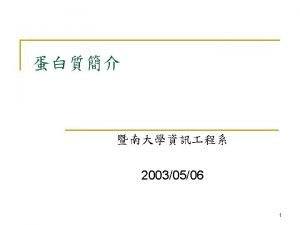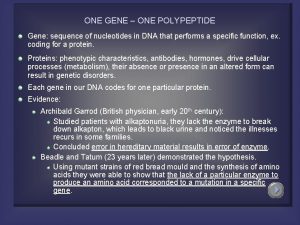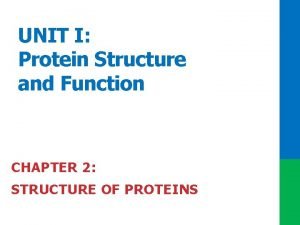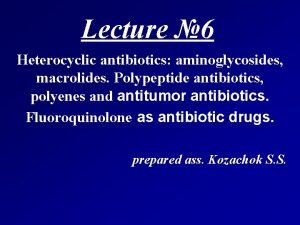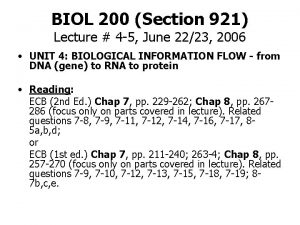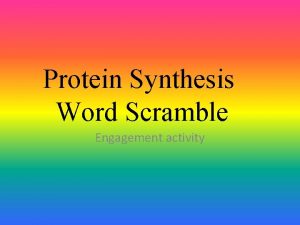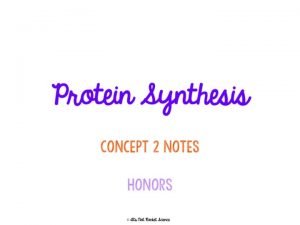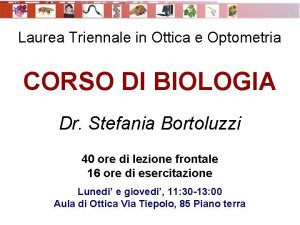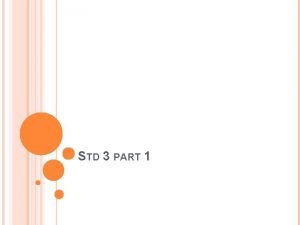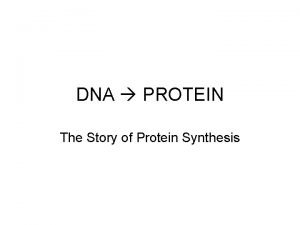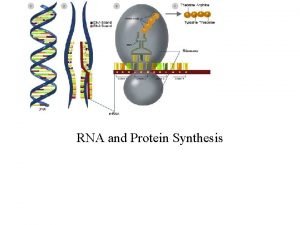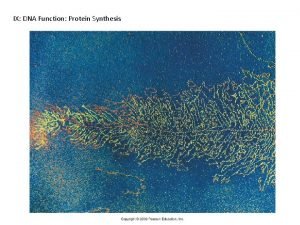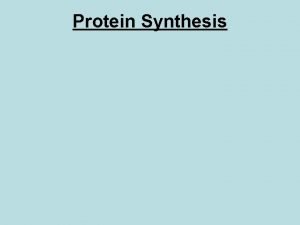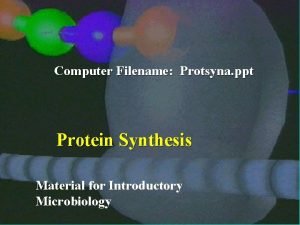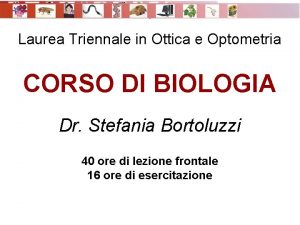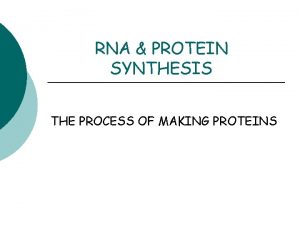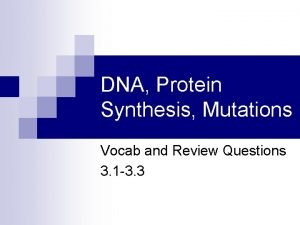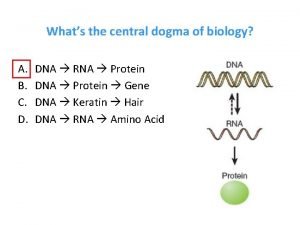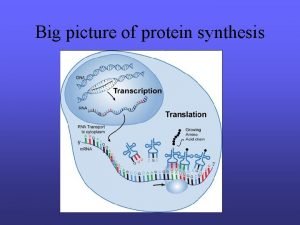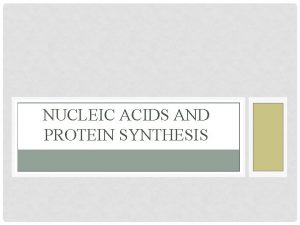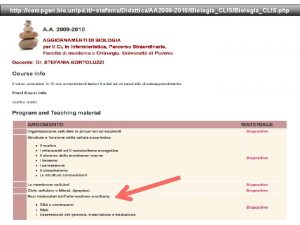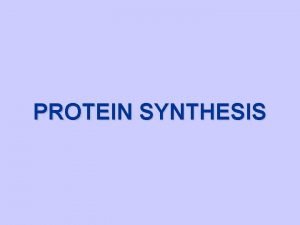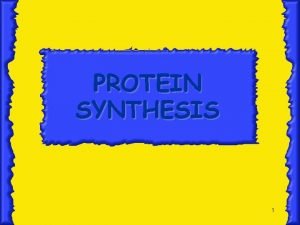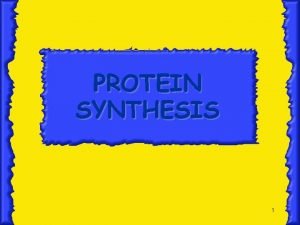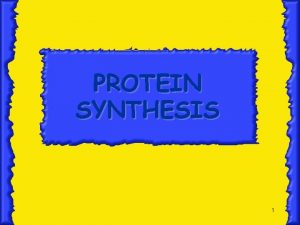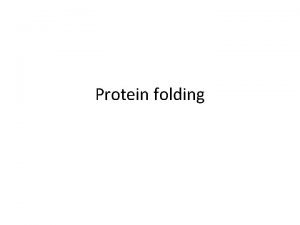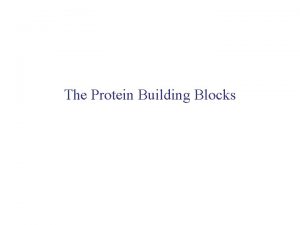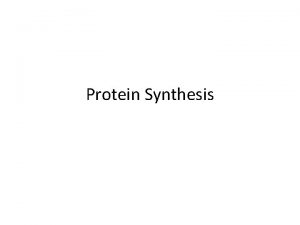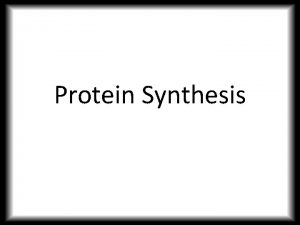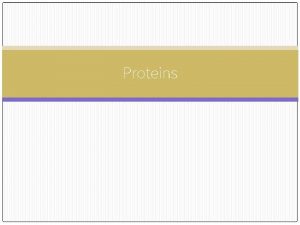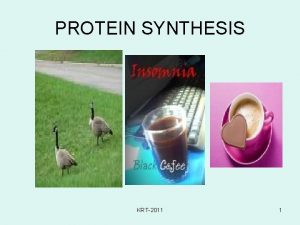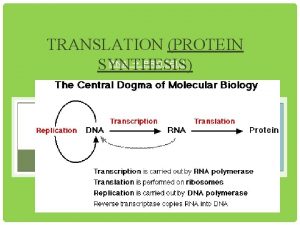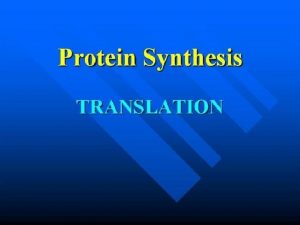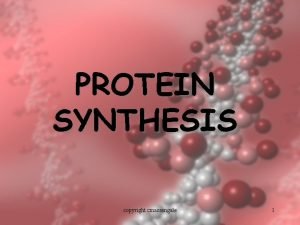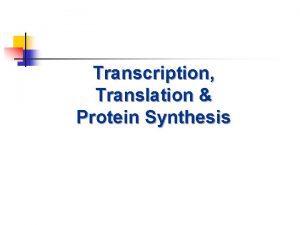Protein Synthesis The production synthesis of polypeptide chains




































- Slides: 36

Protein Synthesis § The production (synthesis) of polypeptide chains (proteins) § Two phases: Transcription & Translation § m. RNA must be processed before it leaves the nucleus of eukaryotic cells

Pathway to Making a Protein DNA m. RNA t. RNA (ribosomes) Protein 2

RNA Differs from DNA 1. RNA DNA 2. RNA DNA 3. RNA DNA has a sugar ribose has a sugar deoxyribose contains the base uracil (U) has thymine (T) molecule is single-stranded is double-stranded 3

Structure of RNA 4


. Three Types of RNA • Messenger RNA (m. RNA) carries genetic information to the ribosomes • Ribosomal RNA (r. RNA), along with protein, makes up the ribosomes • Transfer RNA (t. RNA) transfers amino acids to the ribosomes where proteins are synthesized 6

Messenger RNA (m. RNA) carries copies of instructions for assembling amino acids into proteins.

Ribosomes are made up of proteins and ribosomal RNA (r. RNA).


During protein construction, transfer RNA (t. RNA) transfers each amino acid to the ribosome.

Protein Synthesis DNA molecule DNA strand (template) 5¢ 3¢ TRANSCRIPTION m. RNA 5¢ TRANSLATION Protein 3¢ Codon

Genes & Proteins § Proteins are made of amino acids linked together by peptide bonds § 20 different amino acids exist § Amino acids chains are called polypeptides § Segment of DNA that codes for the amino acid sequence in a protein are called genes 12

Two Parts of Protein Synthesis § Transcription makes an RNA molecule complementary to a portion of DNA § Translation occurs when the sequence of bases of m. RNA DIRECTS the sequence of amino acids in a polypeptide 13

Genetic Code § Every three bases on DNA stands for ONE amino acid § Each three-letter unit on m. RNA is called a codon § Most amino acids have more than one codon! § The code is nearly universal among living organisms 14

15

Transcription Translation 16

Overview of Transcription § During transcription in the nucleus, a segment of DNA unwinds and unzips, and the DNA serves as a template for m. RNA formation § RNA polymerase joins the RNA nucleotides so that the codons in m. RNA are complementary to the code in DNA 17

Transcription DNA is copied in the form of RNA This first process is called transcription. The process begins at a section of DNA called a promoter.

RNA Polymerase § Enzyme found in the nucleus § Separates the two DNA strands by breaking the hydrogen bonds between the bases § Then moves along one of the DNA strands and links RNA nucleotides together 19

RNA

Messenger RNA (m. RNA) • Carries the information for a specific protein • Made up of 500 to 1000 nucleotides long • Sequence of 3 bases called codon • AUG – methionine or start codon • UAA, UAG, or UGA – stop codons 21

A codon consists of three consecutive nucleotides on m. RNA that specify a particular amino acid.

Messenger RNA (m. RNA) start codon m. RNA A U G codon 1 G G C codon 2 protein methionine glycine U C codon 3 serine C A U C codon 4 isoleucine G G C codon 5 glycine G C A codon 6 U A codon 7 stop codon alanine Primary structure of a protein aa 1 aa 2 aa 3 peptide bonds aa 4 aa 5 aa 6 23 A

The Genetic Code Copyright Pearson Prentice Hall

Transfer RNA (t. RNA) • Picks up the appropriate amino acid floating in the cytoplasm • Transports amino acids to the m. RNA • Have anticodons that are complementary to m. RNA codons • Recognizes the appropriate codons on the m. RNA and bonds to them with H-bonds 25

Translation • Synthesis of proteins in the cytoplasm • Involves the following: 1. m. RNA (codons) 2. t. RNA (anticodons) 3. ribosomes 4. amino acids 26

Translation is the decoding of an m. RNA message into a polypeptide chain (protein). Translation takes place on ribosomes. During translation, the cell uses information from messenger RNA to produce proteins. Nucleus Copyright Pearson Prentice Hall m. RNA

The ribosome binds new t. RNA molecules and amino acids as it moves along the m. RNA. Phenylalanine Methionine Ribosome m. RNA Start codon t. RNA Lysine

Protein Synthesis Translation

The process continues until the ribosome reaches a stop codon. Polypeptide Ribosome

• http: //www. youtube. com/watch? v=NJxob gk. PEAo





 Production pre production post production
Production pre production post production Polypeptide chain
Polypeptide chain One gene one polypeptide
One gene one polypeptide What is the stimulus for the release of erythropoietin
What is the stimulus for the release of erythropoietin Polypeptide naming
Polypeptide naming Strepyomycin
Strepyomycin Alberts
Alberts Carrier vs channel proteins
Carrier vs channel proteins Protein-protein docking
Protein-protein docking Protein synthesis gcse
Protein synthesis gcse Protein synthesis scramble
Protein synthesis scramble Molecular genetics and biotechnology
Molecular genetics and biotechnology Protein synthesis
Protein synthesis Sintese de proteinas na celula
Sintese de proteinas na celula Messenger rna codons
Messenger rna codons Which best summarizes the process of protein synthesis?
Which best summarizes the process of protein synthesis? Protein synthesis story
Protein synthesis story Dna cookbook analogy
Dna cookbook analogy Section 12 3 rna and protein synthesis
Section 12 3 rna and protein synthesis Catalytic functions
Catalytic functions Steps of protein synthesis
Steps of protein synthesis Translation protein synthesis
Translation protein synthesis Protein synthesis ppt
Protein synthesis ppt Protein synthesis
Protein synthesis Protein synthesis
Protein synthesis Protein synthesis restaurant analogy
Protein synthesis restaurant analogy Concept map of protein synthesis
Concept map of protein synthesis Protein synthesis and mutations
Protein synthesis and mutations Whats the central dogma of biology
Whats the central dogma of biology Nucleic acid made up of
Nucleic acid made up of Totipotent cells
Totipotent cells Picture transcription
Picture transcription Protein synthesis
Protein synthesis Protein synthesis and mutations
Protein synthesis and mutations Dna vs rna diagram
Dna vs rna diagram Protein synthesis
Protein synthesis Translation or transcription
Translation or transcription

